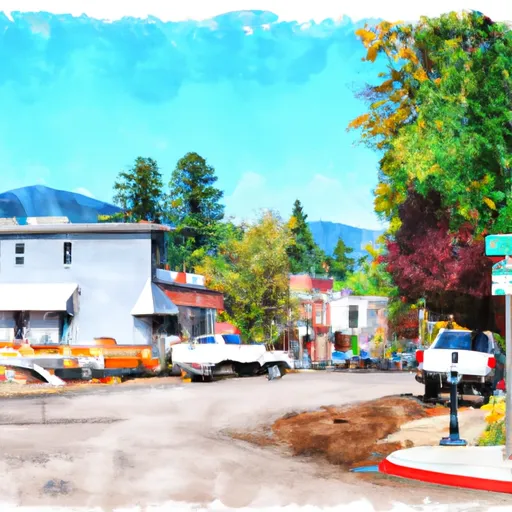-
 Snoflo Premium
Snoflo Premium
Get unlimited access to all our content
With no Ad interruptions! - Start Your Free Trial Login with existing account
Colville
Eden Index
Climate
8.1
•
Recreation
4.5
•
Community
•
Safeguard
4.8/10

Colville is a charming city located in Stevens County, Washington. The climate is generally mild, with hot summers and cold winters. The area is characterized by a mix of coniferous forests and grasslands, with several rivers and streams running through the region. Hydrology constituents include the Columbia River, the Kettle River, and Lake Roosevelt. Outdoor enthusiasts will find plenty of activities to keep them busy in Colville, including hiking, skiing, biking, fishing, and hunting. There are several parks and trails in the area, including the Colville National Forest, which offers over 1.1 million acres of outdoor recreational opportunities. Overall, Colville is a great destination for those looking to enjoy the beauty of Washington State's natural landscapes.
What is the Eden Index?
The Snoflo Eden Index serves as a comprehensive rating system for regions, evaluating their desirability through a holistic assessment of climate health, outdoor recreation opportunities, and natural disaster risk, acknowledging the profound impact of these factors on livability and well-being.
Climate Health Indicator (CHI): 8.1
Colville receives approximately
789mm of rain per year,
with humidity levels near 74%
and air temperatures averaging around
7°C.
Colville has a plant hardyness factor of
6, meaning
plants and agriculture in this region thrive during a short period during spring and early summer. Most
plants will die off during the colder winter months.
By considering the ideal temperature range, reliable water supplies, clean air, and stable seasonal rain or snowpacks, the Climate Health Indicator (CHI) underscores the significance of a healthy climate as the foundation for quality living.
A healthy climate is paramount for ensuring a high quality of life and livability in a region, fostering both physical well-being and environmental harmony. This can be characterized by ideal temperatures, reliable access to water supplies, clean air, and consistent seasonal rain or snowpacks.
Weather Forecast
Streamflow Conditions
Upper Columbia
Area Rivers
Upper Columbia
Snowpack Depths
Upper Columbia
Reservoir Storage Capacity
Upper Columbia
Groundwater Levels
Recreational Opportunity Index (ROI): 4.5
The Recreational Opportunity Index (ROI) recognizes the value of outdoor recreational options, such as parks, hiking trails, camping sites, and fishing spots, while acknowledging that climate plays a pivotal role in ensuring the comfort and consistency of these experiences.
Access to outdoor recreational opportunities, encompassing activities such as parks, hiking, camping, and fishing, is crucial for overall well-being, and the climate plays a pivotal role in enabling and enhancing these experiences, ensuring that individuals can engage in nature-based activities comfortably and consistently.
Camping Areas
| Campground | Campsites | Reservations | Toilets | Showers | Elevation |
|---|---|---|---|---|---|
| Chewelah City Park | 14 | 1,669 ft | |||
| Colville Fairgrounds RV Park | None | 1,567 ft | |||
| Starvation Lake- State Forest | 6 | 2,425 ft | |||
| Big Meadow Lake | 28 | 3,432 ft | |||
| Flodelle Creek- State Forest | 8 | 3,105 ft | |||
| Douglas Falls Grange Park- State Forest | 8 | 1,797 ft | |||
| Little Twin | 15 | 3,721 ft | |||
| Rocky Lake- State Forest | 7 | 2,256 ft |
Nearby Ski Areas
Catastrophe Safeguard Index (CSI):
The Catastrophe Safeguard Index (CSI) recognizes that natural disaster risk, encompassing floods, fires, hurricanes, and tornadoes, can drastically affect safety and the overall appeal of an area.
The level of natural disaster risk in a region significantly affects safety and the overall livability, with climate change amplifying these risks by potentially increasing the frequency and intensity of events like floods, fires, hurricanes, and tornadoes, thereby posing substantial challenges to community resilience and well-being.
Community Resilience Indicator (CRI):
The Community Resilience Indicator (CRI) recognizes that education, healthcare, and socioeconomics are crucial to the well-being of a region. The CRI acknowledges the profound impact of these elements on residents' overall quality of life. By evaluating educational resources, healthcare accessibility, and economic inclusivity, the index captures the essential aspects that contribute to a thriving community, fostering resident satisfaction, equity, and social cohesion.

